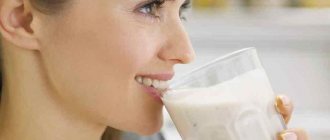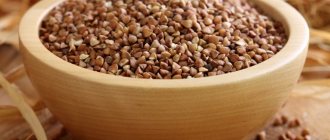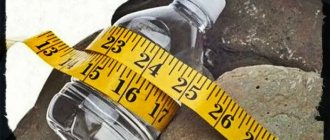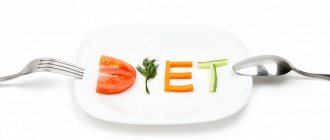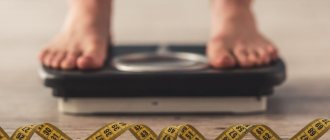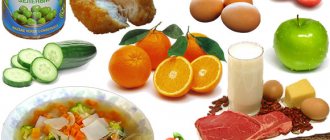What should be the right way out of the diet?
Everyone knows that in order to achieve a slim figure, you need to stick to a diet. And how often it happens that the result immediately disappears after the person losing weight decides not to stick to the chosen diet.
A person losing weight needs enormous willpower in order not to “break down”. Moreover, in addition to this skill, you need to have certain knowledge that allows you to correctly “exit” the diet. Only this will prevent you from gaining excess weight suddenly.
Diet is always a restriction of calories consumed per day
There are several generally accepted rules, following which you can achieve a positive result and exit the diet “with dignity.”
Dieting is a temporary measure aimed at weight loss by limiting calorie intake. You can go on a diet quickly, but you need to get out of it wisely.
The main secrets of the correct way out of the diet:
- The diet involves limiting the size of food. This means that for some period of time you ate small portions. Quitting a diet should not mean that you can afford to immediately eat a huge dish of even healthy food
- Give preference to vegetables, increase their quantity in the first few weeks of “coming out” and do not eat excessive amounts of cereals, meat and fruits
- If your diet included non-fatty fish, feel free to increase their size. Steamed fish is welcome
- Fats and carbohydrates should be introduced into the diet very slowly. Moreover, this does not mean that you can return to rolls and chocolates! Only 200 extra kcal should appear in your diet
- Try to engage in gentle physical exercise. Whatever one may say, diet is stress for the body. Excessive and intense training immediately after release can give an unfavorable load. Choose running, Pilates or dancing
- Don't forget to drink water. The norm per day is two liters, this does not count soups and food.
- It’s good if you worry about the vitamin complex and buy multivitamins for yourself
- Eliminate bad eating habits: reading, TV. Watch your food, listen to your stomach in time and understand that you are already full
- Don't eat at night or before bed. The favorable time for the last meal is four hours before bedtime. If you feel terrible hunger, drink tea with dried fruits
the right way out of the diet will not allow you to gain extra pounds
Important: Quitting the diet should last from ten days to two weeks. After this time, you need to completely switch to proper nutrition.
How to avoid weight gain after dieting?
Many people are interested in how to get out of a diet correctly. To avoid weight gain, you should follow the key recommendations of nutritionists:
- Gradually move from thermally processed vegetables and fruits to fresh ones. Moreover, their number needs to be increased gradually.
- There is meat and fish. Preference should be given to low-fat varieties.
- For 2 weeks, add 200 g of fat to the menu. It is also acceptable to eat a small amount of avocado, dark chocolate, and grapes. Whole grain bread also has benefits.
- Exercise. In this case, it is necessary to gradually increase the intensity of physical activity.
- Maintain water balance. You need to drink at least 2 liters of clean water per day. The volume does not include juices and herbal teas.
- Drink vitamins.
- Concentrate on food. At this time, it is not recommended to watch TV, use gadgets or read books.
- Stick to fractional meals. You need to eat 5-6 times a day in small portions.
- Avoid eating at night. You should eat your last meal a few hours before bedtime.
- It’s worth leaving the diet menu smoothly. Moreover, this period lasts no more than 2 weeks.
How to get out of a protein diet?
The protein diet is one of the most popular. Its success is ensured by its incredible effectiveness, since the products of this diet are saturated with protein and that is why the muscles are able to withstand loads, and satiety comes for a long time.
The protein diet menu is quite varied and a person on it is unlikely to experience any deficiencies in his diet. But the body is able to get used to the same type of food and react sharply to another: fatty and carbohydrate. This is why cases of rapid weight gain are often observed after following a protein diet for a long time.
protein diet
Important: When leaving a protein diet, you need to forget about carbohydrates, since their consumption can cause stress on the body.
A balanced diet over the next two weeks after leaving the diet will help consolidate the results:
- In the next two weeks after the protein diet, try to forget about sweets and junk food. Give preference to light breakfasts and if you really can’t bear it, season your oatmeal with a spoon of honey
- Drink only tea without sugar, eat cereals and low-fat dairy products for breakfast
- Lunch is the perfect time for vegetables and lean meats. Here your soul can roam and choose for itself: fish, chicken, beef, stew, zucchini, fruit. Wash down your meals with herbal or green tea. Eating eggs is encouraged
- Dinner should be quite light: for example, a piece of boiled meat, vegetable salad and a boiled egg. If you feel very hungry before bed, drink a glass of low-fat kefir
- Sweets for you are: fruits, yogurt, honey. They should be allowed in limited quantities and preferably in the first half of the day.
carbohydrates entering the body after a protein diet always cause stress
Important: Try to eat often, but in small portions. With this condition, it will be easier for the body to adapt to a proper diet.
Why is he so important
Many experts consider breaking out of fasting to be one of its stages, without which the technique will not work. If it is not organized correctly, you can pay for it not only with your health, but also with your life. Unfortunately, there are cases where neglect of recommendations resulted in death. Therefore, it is so important to devote as much attention and time as possible to the recovery period.
What are its main functions:
- help the body adapt from internal sources of nutrition to external ones;
- ensure a gradual transition to a normal diet;
- remove toxins freely circulating in the body;
- start the digestive tract;
- restore the normal functioning of all organs without risk to health;
- mitigate the next stress for the body;
- minimize side effects and complications.
When recovering from fasting, important health processes occur in the body that you need to be able to control.
With the very first sip of juice (it is with this drink that it is usually recommended to start your exit) you will feel truly brutal hunger. During abstinence from food, it becomes dulled, as the body gets used to making do with internal reserves and the stomach stops sending appropriate signals to the brain. But as soon as the receptors sense the taste of food, the digestive system awakens and turns you into an insatiable giant who wants to eat everything that is in sight. Therefore, the first task of the recovery period is to tame this inner glutton.
After fasting, there are still poisons in the blood and tissues, and in considerable quantities. Many people wonder how this is possible: isn’t the goal of abstinence to cleanse the body of all these toxins? Yes, most of them are excreted, but the formation of breakdown products during metabolic processes occurs continuously. At the moment when you complete your test, some harmful substances that have already been released from the cell are circulating either in the intercellular space, or in the blood, or in the lymph. They are already ready to leave the body, but do not have time to do this, since the hunger strike is over.
If the exit is not organized correctly, all these poisons will return back into the cells and spread through the blood to the organs. It turns out that the effect of fasting will be neutralized. But this is not the worst thing. If during the recovery period you eat prohibited foods or allow yourself an extra piece, many additional harmful substances will enter the body with food. An empty stomach will immediately release them into the blood, which can cause severe intoxication. Hence the cases of death.
This means that the second main task of the exit is to remove freely circulating toxins, poisons and other toxic debris remaining from the body after fasting and prevent new ones from entering it.
How to get out of the buckwheat diet, menu for the week?
- The buckwheat diet has become extremely popular lately. Its success is so great because in a short period of time the diet can rid a person who is losing weight of the hated extra pounds. It's happening fast
- But what is the secret of the buckwheat diet? The fact is that while eating only buckwheat, the body uses up not only fat reserves, but also protein accumulated in the muscles
- If the exit from the diet is not adjusted correctly, it is quite possible that your body will react to this with great stress and will want to replenish lost reserves doubly
buckwheat diet
It is safe to say that the buckwheat diet is a real “hunger strike”. You need to get out of it correctly and carefully:
- Keep track of all the calories you consume during the first five days. Their total amount should not exceed 600 kcal per day
- For the next 10-14 days, also monitor your diet and try to consume no more than 1500 kcal per day
- For the first two weeks, your diet should include lean meats, vegetables and fruits.
Approximate menu for exiting the buckwheat diet for a week:
Monday:
- Breakfast: reduce the usual portion of buckwheat by half, add an apple and an orange to breakfast, wash it down with a glass of kefir
- Lunch: reduce the usual portion of buckwheat by half, add 100 grams of boiled lean meat and one egg to the menu. Make a fresh salad and wash down your lunch with green tea
- Dinner: a small portion of buckwheat and fresh salad. Before going to bed, you can drink a glass of low-fat kefir
Tuesday:
- Breakfast : half a portion of buckwheat, low-fat yogurt, fruit, boiled egg, tea
- Lunch: soup, a slice of bran bread, fresh vegetables, juice or tea
- Dinner: half a portion of buckwheat, steamed fish, a glass of kefir
Wednesday:
- Breakfast: half a portion of buckwheat, cottage cheese or kefir, fresh fruit, juice
- Lunch: low-fat first course, half a serving of buckwheat, vegetables or stew, herbal or green tea, fresh fruit
- Dinner: half a portion of buckwheat, fresh vegetables, kefir
Thursday:
- Breakfast: half a serving of buckwheat, fresh fruit, yogurt, granola or dried fruit
- Lunch: first course, stew or stewed cabbage, kefir, fresh fruit
- Dinner : boiled egg, fresh salad, steamed fish, kefir
Friday:
- Breakfast: oatmeal or buckwheat, low-fat yogurt and fresh fruit, juice
- Lunch: first course, vegetable stew or lean meat, boiled egg, kefir
- Dinner: boiled egg, fresh lard, tea with dried fruits
Saturday:
- Breakfast: oatmeal with dried fruit, fresh fruit and yogurt
- Lunch : first course, cereal with boiled fish, fresh vegetables
- Dinner: low-fat cottage cheese with dried fruits
Sunday:
- Breakfast: oatmeal or any other porridge with fruit and yogurt
- Lunch: first course, vegetable and cereal second courses, lean meat and fish
- Dinner: low-fat cottage cheese, vegetable salads, boiled eggs
How to eat after the Japanese diet so that the weight does not return
It will not be possible to completely maintain the weight of the diet; 1-2 kg will still return if salt and some other products are included in the diet. No need to worry, it's just water.
How to eat when leaving:
- You can have three or five meals a day, depending on your work or study schedule.
- A single serving should not exceed 250 grams, with the exception of vegetable salads without fatty sauces. They can be consumed in any quantity.
- It is advisable not to combine food and drink. Firstly, it complicates digestion. Secondly, there is no need to stretch the stomach.
- We pay attention to sauces. They are often higher in calories than the dish itself. You can make your own dressings and sauces from tomatoes, natural yogurt, unrefined oils, spices, and lemon juice.
- We definitely eat fresh vegetables. They contain many useful substances, are low in calories, and fiber will improve the functioning of the gastrointestinal tract.
By the way, periodic or intermittent fasting with eating windows of 16/8 or 20/4 is now at the peak of popularity. Such systems can be used to maintain results and maintain weight, but this does not cancel diet control.
Exit from the Favorite diet, menu for the week
It’s not for nothing that this diet has the name “Favorite”. It is extremely popular and enjoys great success due to the fact that it can quickly get rid of extra pounds. Since the diet menu is quite strict, the exit from it must be correct.
components of the “Favorite” diet
Important: Leaving your “favorite” diet should be a smooth transition to a proper diet. A competent “exit” guarantees the consolidation of the effect.
Menu:
- Breakfast: two boiled eggs
- Second breakfast: fresh apple
- Lunch: vegetable soup with water, boiled piece of meat
- Afternoon snack: orange or grapefruit
- Dinner: steamed vegetables
- Second dinner: kefir
How to return to normal eating:
- Try to introduce one new food into your diet every day
- Calorie content should not exceed 1000 kcal per day
- The portion of food consumed should not be larger than your palm
- Take a fasting day once a week
conclusions
Coming out of fasting is a gradual, slow process, during which it is very important to follow all the recommendations of specialists, strictly adhering to them. Those who do not have experience in abstaining from food should not practice fasting for more than 1-2 days.
Accordingly, recovery after such fasting will be easier. These unique fasting days will help you lose weight and feel good and light. However, for those who intend to fast for a long time, both during the period without food and during recovery, it is advisable to be observed by a doctor and inform him of changes in well-being.
How to get out of the Maggi diet, menu for the week?
The Maggi diet is also called the “Egg diet”. To consolidate the results, the exit from it must be correct:
- include in your diet foods that were rich in your diet: eggs, grapefruits, oranges and cottage cheese
- After the diet, you should follow the rules of proper nutrition
- do not consume carbohydrates after 12 noon
- do not eat food at night and before bedtime
- drink enough water
components of the Maggi diet
Weekly exit menu:
- Breakfast: boiled eggs, citrus fruit, low-fat cottage cheese
- Second breakfast: fruits or vegetables
- Lunch: vegetable soup, slice of cheese, chicken breast
- Afternoon snack: cottage cheese, fruit, tea
- Dinner: boiled eggs, fresh vegetables, low-fat cottage cheese
- Second dinner: fermented milk product
Spontaneity is the main enemy
A diet started spontaneously and abruptly does not lead to success. Without proper preparation, following a strict diet can lead to depression. A painful feeling of hunger prevents you from leading your usual lifestyle. The weight comes off slowly, and the kilograms lost after the diet quickly return. Hence the breakdown, remorse, self-pity and active eating of sweets.
How to avoid the problem? Know: success in losing weight lies not only in strict adherence to the menu, but also in the competent process of entering and exiting the diet.
Preparing for a diet involves cleansing the body and gradually changing your diet. Systematic refusal of junk food and establishment of a drinking regime minimizes the risk of stressful situations and reduces the feeling of hunger.
A smooth exit from the diet is designed to restore the body’s strength and achieve a comfortable state of health. Following several important rules will allow you to fix your desired weight and maintain it for a long time.
How to get out of the chocolate diet, menu for the week?
The chocolate diet is one of the most “hungry” and the correct exit from it guarantees the effectiveness of the diet itself. The diet of the chocolate diet is meager: half a bar of dark chocolate, coffee and skim milk. Exiting the diet should meet all the body's needs.
The chocolate diet does not involve eating anything other than chocolate.
Exit from the chocolate diet:
Monday: Since the stomach is weaned from food, it needs to find food that will not damage its walls. On the first day of release, introduce shredded cabbage and carrots into your diet. Season the salad with lemon juice. Chew your food thoroughly.
Tuesday: Since the body did not receive beneficial microelements during the chocolate diet, on Tuesday fill it with fruits and berries for breakfast and dinner. For lunch, drink a glass of lean broth without salt
Wednesday: Replenish the protein lost in the body: eat boiled chicken breast for lunch, and a fermented milk product for dinner
Thursday: Try to eat small, frequent meals. Fill your menu with fruits, berries, vegetables and lean fish and poultry
Friday: Eat 6 times a day, include a new product in your diet every day. Allow yourself some light sports.
Saturday and Sunday: these days will be the transition to proper nutrition. Do not introduce harmful foods into your diet. Try to replace fatty foods with vegetables, fruits and cereals.
Exit from the apple diet, menu for the week
The apple diet promises ten kilograms of weight loss in just one week. A sharp weight loss may not stick if the diet is not followed correctly.
Apple diet “cleanses” the body
Monday: You can't give up apples - they're still an important staple in your diet. On the first day of going out, include low-fat cottage cheese in your diet for breakfast, lunch and dinner.
Tuesday: For breakfast, cook yourself unsweetened oatmeal with water. For lunch, you can indulge in low-fat vegetable soup. Dinner: apples and cottage cheese.
Wednesday: Breakfast of your choice: oatmeal or cottage cheese with honey and apples. Lunch - vegetable soup with a piece of meat. Dinner: fermented milk product, one boiled egg and apples.
Thursday: Breakfast of your choice: oatmeal or cottage cheese with honey and apples. Lunch: vegetable stew and boiled meat. You can diversify your food with steamed fish.
Friday: Include boiled eggs and low-fat yogurt in your breakfast. Lunch - be sure to have a first course and lean meat. Dinner - kefir, cottage cheese, apples, dried fruits.
Saturday and Sunday: breakfast should be nutritious, give preference to cereals and dairy products. Lunch should contain a first and second course; steam vegetables and meat. Dinner: low-fat cottage cheese and fruit.
Output Features
The first product that is recommended after leaving is juices from vegetables and fruits. At first they are diluted with water, later they are consumed undiluted. Such juices are consumed in small quantities every two hours. The next category of products that is introduced into the diet is fermented milk food, as well as porridge. Next, you can gradually introduce nuts and seeds into the menu. But it is better to abstain from meat food for as long as possible in order to increase the positive effect of fasting.
Since recovery processes in the body last a long time, up to 3 months, during this period you should try to eat only high-quality food. The basis of the diet during this period is vegetable and dairy dishes.
Exit from a low-calorie diet, menu for the week
Exiting a low-calorie diet should be smooth so that the body does not react to it with stress. The menu for quitting such a diet is quite monotonous. Try to introduce a new food every day and do not eat too large portions.
This diet limits the number of calories consumed per day.
Daily menu for quitting a low-calorie diet:
Breakfast:
- feta cheese or any other low-fat cheese 100 grams (this is approximately 300 kcal)
- a slice of rye bread or crispbread, no more than 4 pieces (400 kcal)
- tomato juice – 40 kcal
Second breakfast: one fruit and a handful of nuts total up to 300 calories
Dinner:
- borscht without meat or vegetable soup (about 200 kcal)
- fish or chicken fillet with vegetables (about 200 kcal)
Snack: apple or pear - about 100 kcal
Dinner: boiled buckwheat, low-fat cottage cheese, vegetables or a piece of boiled breast - about 400 kcal
How to get out of a diet: tips and reviews
Each person chooses a diet for himself that can give him relief from excess weight. Of course, it is recommended to first consult a doctor about this, because every diet has many contraindications.
The exit from any diet should be competent and smooth, so as not to frighten an already exhausted body. Each diet is only for a certain part of the time and it is necessary to complete the exit with a proper nutrition regimen.
Important: If you decide to take the path of fighting excess weight with the help of a diet, you must completely give up any harmful foods, fast food, sugary drinks, etc.
